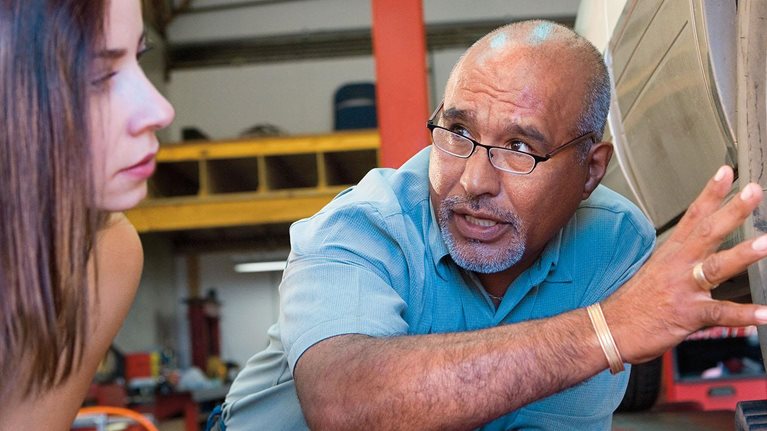A company’s relationship with its customers is about much more than improving product ratings or decreasing wait times. Understanding the customer journey is about learning what customers experience from the moment they begin considering a purchase, and then working to make the journey toward buying a product or service as simple, clear, and efficient as possible. In this episode of the McKinsey Podcast, McKinsey principals Harald Fanderl and Nicolas Maechler talk with McKinsey’s Bill Javetski about what companies have to gain from focusing on the customer experience and how they can evaluate and enhance the purchasing journey.
Want to subscribe to The McKinsey Podcast?
Podcast transcript
Bill Javetski: Welcome to another episode of the McKinsey Podcast. Hello, I’m Bill Javetski, an executive editor with McKinsey Publishing. I think today’s topic is one that everyone will have their own stories to tell about. It’s customer experience. Think back for a moment to the last time you called your electric company or your cable company or you filed an insurance claim or ordered something online. Maybe you took a trip on an airline or by taxi. You’ll probably have a memory of how the whole experience felt. When you were done, did you like the experience? Did you hate it? What did you think of the company that provided it?
Well, companies are thinking a lot about how they treat their customers. So we’re going to talk about what it means to put a customer’s needs and wants at the center of a business strategy. My guests today are Harald Fanderl, a partner in McKinsey’s Munich office. Welcome, Harald.
Harald Fanderl: Hello, Bill.
Bill Javetski: We’re also joined by Nicolas Maechler, a partner in McKinsey’s Paris office. Welcome, Nicolas.
Nicolas Maechler: Hello, Bill.
Bill Javetski: The two of you have just been collaborating on a compendium of articles on customer experience. So, Harald, let me start with you. Customer experience seems to be a big business topic now. What exactly are we talking about when we talk about customer experience? Is it customer service or customer satisfaction or is it something else?
Harald Fanderl: When we talk about customer experience, Bill, it’s actually all of the above. It’s all about putting customer needs at the center of what a company needs to do, and then ensuring along all the touchpoints and even more so along all the relevant customer journeys that the customers have a flawless experience. When a customer is satisfied with a company, they are also lower in the cost to serve, but also have a higher potential to be more loyal customers for this company. And maybe they’ll even promote this company among their friends.
Bill Javetski: This idea of touchpoints and journeys, can you explain that a bit more?
Harald Fanderl: Happy to do so. At the center of what we are discussing at McKinsey, all around customer experience, is the concept of customer journeys. We used to discuss improvements of customer touchpoints, but we see when we also do analytical research that in order to satisfy customer needs, you typically need more than one customer touchpoint to satisfy a need. This could be to join a company, to pay a bill, or to change something in your address. As that is more than one touchpoint, it’s important that you as a company have the whole journey in sight. Then think about how you can improve this customer journey.
The complexity comes when you go deeper and understand that companies are often organized in silos for multiple customer journeys. Therefore, this cross-functional collaboration is crucial for putting the customer need in the center and then working together in multiple areas of the company, be it the more sales-driven guys, the marketing guys, the operational guys, and even support areas like IT and finance, to then jointly work and improve this customer journey along the various touchpoints.
Bill Javetski: If I’m hearing you, then a touchpoint is kind of an individual transaction? I call the call center and tell them I’m complaining that my electricity is off. This journey is the accumulation of all of my touchpoints, all of my contacts, with the company over a period of time? That sounds like a lot to digest for a customer and for a company as well. What is the difference between this idea of a touchpoint and a customer journey? Nicolas, can you illuminate us on that?
Nicolas Maechler: Sure. Basically, we go back to the customer need. When you want to interact with a company, there is something you want to achieve. Either you want a new product, you want to buy something, you want to complain about something that is broken, something is wrong, one of your bills is wrong. That’s the basic need. The different touchpoints you’re interacting with are just ways for you as a customer to fulfill that need or solve that problem. Going back there and understanding the combination of touchpoints that will actually deliver this satisfaction to you or fulfill this need for you, is what we do. We take a full end-to-end view of the customer need, and that’s what we believe is the right way of approaching customer experience.

Would you like to learn more about our Operations Practice?
Bill Javetski: This journey, how long can it take?
Nicolas Maechler: Sometimes it’s very long. If you think about buying a car, in most countries today, you have car configurators online. So you go there, you have an ID, you look at one brand, and you configure your car. Then maybe a few weeks later, you pay a visit to the dealer, and you test drive that car. Maybe you hesitate again, and then you have a financing discussion later on. But if you don’t connect these elements, you don’t have the view of one single journey, which is, “I want a new car.” It can span over a period of a few days or sometimes a few weeks. It can go even to months when it doesn’t go right. If the company’s not solving the problem, it can go up to months. That’s usually not a good sign.
Harald Fanderl: Yeah, Nicolas, let me add an example from the energy space. When we looked at that example, we saw that they had actually up to 18 touchpoints with customers to organize a customer move from one house to the other. But they didn’t have the full view across all these touchpoints of what they wanted to achieve. They had 18 touchpoints. They had more than 60 people that worked on these moves in various departments, but there was no single person responsible to orchestrate these various teams and touchpoints to fulfill this need smoothly.
What we did here, with the clients, we put ourselves deeply into the shoes of the customer, did some focus groups and found out, of course, that this period of moving is a very stressful time. So energy is probably not at the top of your mind. Then we organized a cross-functional team with the marketing department, the operations team, IT, and the digital team. Based on the insights we got from the customer feedback, we found out that to smooth the process, we needed to figure out how long it takes to make this move happen.
On top of this, we thought about, “Do we need all these 18 touchpoints? Can we shorten this whole process significantly?” By collaborating cross-functionally and continuously, also involving customers for feedback, we were able to reduce that amount of time needed for this journey from six weeks to under one week, and also increase customer satisfaction by more than 30 percent.
Bill Javetski: If this involves the marketing department and the operations function and IT, it sounds like a very complicated process, from a company’s standpoint. What is driving this? Are customers demanding this kind of end-to-end service and end-to-end attention to what they’re seeking? Or is it coming from some other source?
Nicolas Maechler: Customers are relatively simple, right? They interact with you, and they want the service that they are expecting to be delivered. What creates the complexity is the company. Through the years, for many reasons, sometimes a new IT system, sometimes regulation, some legal requirements, and so on, add complexities little by little.
Because companies do not focus that much on these end-to-end customer journeys, you end up with an extremely cumbersome experience for customers, which is actually not optimized for the customer, but optimized for the company. What we are advocating now is this shift in perspective, so that the customer becomes the center of attention again.
Harald Fanderl: Nicolas, I think that’s spot on. Maybe let me also add, the demand of the customer is also increasing. That is another thing that you also observe in the marketplaces. Many industries get fully disrupted with new offers. If I only think of the Amazons or the Apples of this world, but also in the telco sector, there’s a lot, especially through the digital revolution that is happening in these sectors, where the customer demands are becoming higher and higher. They are experiencing a full breadth of experiences. Some really stellar and really efficient, and putting the customer in the center. And others in industries like insurance, like energy, and maybe also in the whole healthcare space, where you experience a big opportunity to put customer needs more in the center of what these companies are doing.
Nicolas Maechler: The reason why our clients are now turning to us more and more on this topic of customer experience is that indeed these companies, like Apple, Google, Amazon, Uber, are just raising the bar in terms of customer expectation. If you think about the B2C world, a lot of our clients face customers who have increasing demands.
If I can manage a taxi booking in a very easy way with Uber, why couldn’t I access all my bank accounts in an easy, integrated manner? Or why can’t I subscribe to a new telecom plan through the web as well or through my device? For instance, if I want to buy one for my kids. It’s percolating from these leading-edge companies to the regular B2C world. What I’ve found most interesting in the last 18 to 24 months is that even in the B2B world, this is also coming.
Bill Javetski: So customers are becoming more demanding and comparing different companies against each other when they base their decisions on where to purchase based on their experience.
Nicolas Maechler: Let me make a comment, Bill, about your question earlier in this conversation around the definition of customer experience. Customer experience is a perception. This is not an operational KPI as you usually have in your company. This is a perception driven by a very clear equation. It’s the observed performance that the customer has with its supplier, minus its expectation. A lot of companies want to make sure they do well on customer satisfaction by increasing the observed performance. That’s good. But don’t forget the expectations, because if your expectations are very high and you deliver something in terms of observed performance that is quite standout, people are going to be deceived. Think about all the marketing messages we are getting through advertising every day.
“I’m gonna be the best.” “You will see what you will see.” “We have the best network.” “We have the best this, the best that.” Through advertising, a lot of companies are raising expectations, while delivery is actually quite standard. We’ve found that sometimes lowering expectations can also be a way to deliver higher satisfaction.
To take a real example, one of my clients in the telco space delivering fiber to the home, was in the shops claiming the delivery would happen in the next 8 days. While actually, the back office was rather on average able to deliver around, let’s say, 12 to 15 days, which obviously created a negative perception versus the salesperson’s promise. If you revert the thing and say, “At the moment of the sale, it’s likely to be 12 to 15 days”—people usually already have a broadband connection at home, so it’s not the end of the day if you don’t have it in one week. The overall satisfaction that came out of this process, promising 15 and delivering on it, or sometimes even overdelivering, was far better than saying the contrary.
Bill Javetski: So it’s not necessarily that you attack this with performance gains, but in some ways, you are dealing in the perceptions of what your customers expect and working around those. It sounds like at times it could be a bit manipulative.
Nicolas Maechler: You call it manipulative, but it’s also just the truth, right? If you are unable to deliver on 12 days and your sales guy is just trying to push, push, push to get the sale, this is the manipulation. If you tell him the truth, maybe you’re going to lose the sale. But this is likely to be rather marginal versus having a bad experience in the first two to three weeks.
Bill Javetski: The companies that you mentioned, Apple, Amazon, Uber, these are companies that obviously use digitization to a vast degree. Is it only these newer players that are good at this? Or are there older-line players that are also good at putting customers at the center of their purpose and their strategy?
Nicolas Maechler: You can take a customer-centric approach from any starting point. It’s not limited to a few companies; it’s rather open to anyone. We would claim it’s a performance angle that was long overlooked. One hundred percent of companies focus on their financial performance. All of them focus on their commercial performance. Now there’s a lot of pressure to be good on your environmental performance. You need to be good on your social performance, the way you treat your employees, and so on. Who is actually looking and focusing on the customer performance? So I would argue this is something that is open and required for anyone.
Harald Fanderl: There is a leading European energy player who used to be in the bottom 25 percent in terms of customer satisfaction. The company embraced this whole topic and is now a leader in their country in terms of customer satisfaction. In the pharma healthcare sector there are now also some payers that really take this concept at the core. One of the clients we’ve been supporting managed an increase in one and a half years of more than 25 percent in terms of improvements in customer satisfaction, which went along with a fundamental change of the mind-set and behavior of 6,500 people by introducing the customer journey concept and by, in stages, working on one customer journey after the other.
Bill Javetski: I’d like to talk about what it takes inside a company to begin this kind of a transformation. But before we do that, I’d like to ask what the benefits are of taking a much more customer-centric approach.
Nicolas Maechler: Yes.
Bill Javetski: Does it migrate to the bottom line? Culturally, what can we look at, because companies often talk about strategy and financial benefits. But if you are going to devote a lot of attention to developing better customer relations, the question is going to become, “Well, what advantage will it give us?” Maybe you could explore that a little bit, Nicolas.
Nicolas Maechler: Yes. Indeed, it’s a fair question because we’ve been talking for a while now about improving customer satisfaction, as Harald was just saying. We’ve seen significant improvements in other areas of the business, which are more directly linked to the bottom line through a focus on customer satisfaction. And I’ll come back to that.
But, again, let’s not think, “Let’s hide a cost-reduction program at the back of a customer-centric sort of transformation.” We need to be true to this. So it’s really focusing on our customer satisfaction that has side benefits. I think we’ve seen a lower cost to serve attached to that.
Even without wanting cost actions, we end up doing some because we simplify processes. We improve the end to end. We accelerate digital migration. We avoid repeat interactions and so on. Let’s say 15 to 20 percent of cost reduction is quite often seen. Now, not only costs. It also drives revenues for sometimes obvious reasons like churn avoidance. So people canceling their services with a company. But also types of cross-selling, so adding to your portfolio of services you have with one company. Or even simply, as I’ve seen recently in a B2B case, winning more proposals.
Bill Javetski: Let me pose a situation. I’m a CEO of a company. Maybe it’s a retail company, maybe it’s a business-to-business company. I recognize that I am losing some competitiveness because others in my sector are more customer centric, but I haven’t given much thought to this in the past. How should I attack the problem of getting better at customer experience? What are the fundamentals building blocks of a strategy to improve the way that I treat customers?
Harald Fanderl: It all starts with a vision, really—an aspiration of what do I want to achieve typically that can be also stimulated by an external impulse where there’s a new entrant or, as we discussed earlier, maybe a new, a smaller player offering a more compelling proposition to your customers. Or that you even see in customer-satisfaction ratings that you have a real challenge. If you have a customer-satisfaction problem, it’s important to dig deep and understand why customers perceive us like this.

Customer Experience
Then come to a joint understanding, that’s often not so nice, but it’s a little painful problem that you accept. When you understand where you are in terms of customers and satisfaction, what is the expectation of your customers? Where are you in your current performance?
Then you go back and start looking at what are the most important customer journeys. Often the first step is to take one customer journey, think about how you can work on this customer journey from an internal perspective, and then play toward what would be the expectation from the customer side. Then you get an understanding of where you are, what the aspiration level can and should be.
In a cross-functional team, you start to organize by attributing one leader who most of the time is the guy who has the most touchpoints in this customer journey. You appoint him as the customer journey lead. Then start with him at the various departments that are engaged in the customer-touchpoint process, with many of the tools that we then bring to the table, to come to a continuous improvement all along this customer journey.
Nicolas Maechler: I’ve seen three major components that make a customer-experience transformation successful. First, you need a top-down push. You need the top management to be convinced, to understand and create this conviction or propagate this conviction across the organization. This is good, but that’s not enough.
The second element is the one that Harald was speaking about before, which is to look at the journeys, understand them, sometimes create them when they don’t really exist or they are not formalized, prioritize them, and then go through the main ones and transform them. You look at major cost items, what’s creating problems, and rework, rework, rework until you have an increase in customer satisfaction.
The third element, which, in our view, is absolutely crucial to make it last and to ensure a wide adoption around the companies is a feedback-loop system. Yes, there have been a lot of measures around customer satisfaction and even university debates about which measurement system or which indicator is the best.
The point is what you do with it. We believe putting in place a feedback-loop system that actually asks the closest to an event with the client. And typically, to the end of a journey, asking the customer for satisfaction measure or rating. But then feeding it back into the organization. Not only in the form of a dashboard for the management to look at, but for individual stakeholders. So individual field technicians, individual store sales reps. Individual call-center people about their own interaction with their clients, the people they just spoke to, feeding them back the positive, but also the negative ones, is actually very powerful because then they know what they’ve done right, what they’ve done wrong, and how they could improve. They also know the company is kind of taking care of this. It’s really important for the company.
Bill Javetski: That’s a very helpful exploration of a very complex business topic. You can find more of Harald’s and Nicolas’s insights on McKinsey.com and also in their compendium, called Customer experience: Creating value through transforming customer journeys. Thanks to both of them for participating in our podcast. Thanks, Harald.
Harald Fanderl: Thank you, Bill. It was a pleasure to be on this one.
Bill Javetski: Thank you, Nicolas.
Nicolas Maechler: You’re welcome.
Bill Javetski: I hope you’ve enjoyed this podcast. Thanks for listening.


